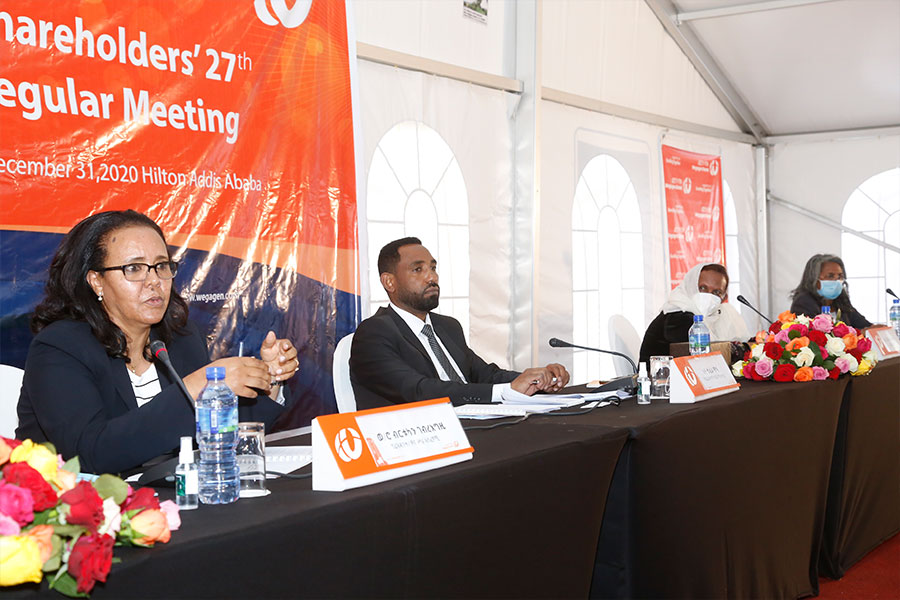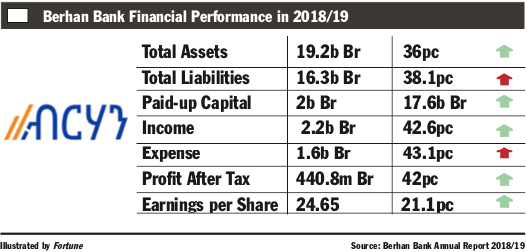
Fortune News | Mar 06,2021
Sep 24 , 2018
By BEHAILU AYELE ( FORTUNE STAFF WRITER )
 Nyala Insurance reported the highest profit in the industry for two successive years, registering 141.3 million Br in net profit, a 22pc increase from last year.
Nyala Insurance reported the highest profit in the industry for two successive years, registering 141.3 million Br in net profit, a 22pc increase from last year. Nyala Insurance reported the highest profit in the industry for two successive years, registering 141.3 million Br in net profit, a 22pc increase from last year.
Nyala topped its closest competitor, Awash Insurance Company, which reported 128.7 million Br in profits last fiscal year.
However, the firm's earnings per share fell by 17 Br to 496 Br. Shareholder return, however, remains the highest in the private insurance industry.
A surge in gross written premiums, commission income, earnings from investment activities are the main causes for improvements that contributed to a rise profits. Also, controls on claims made a positive contribution to the firm's performance.
Last year, Nyala underwrote a gross premium of 769.3 million Br, which soared by 76.5pc.
“We have ventured toward high-risk engineering insurance services,” says Yared Mola, CEO of Nyala. “This has helped push up our gross premiums.”
Income generated from providing insurance coverage for mega projects has boosted the firm’s net result, according to Kemal Mohamed, chairperson of Nyala.
One of the mega projects covered by the insurer is for contractors all-risk and third-party-liability insurance provided for the Koysha Hydroelectric Dam that is under construction by Salini Impergilo s.p.a since 2016. Nyala covered 72 billion Br in insurance risk for the project, which is estimated to cost 2.5 billion euros.
In the reporting period, the firm’s premium portfolio shows that engineering insurance, safeguard to the risks faced by the ongoing construction projects, accounts for more than one-third of the total production followed by motor and fire
Nyala ceded 69pc of its gross written premiums to international reinsurers that include Munich-Re, Swiss-Re and Africa-Re.
The retained value of the firm stood lower than many of the insurance companies, according to Abdulmenan Mohammed, a financial expert with over 15 years of experience.
“With the change in product portfolio, our retention declined,” Yared told Fortune. “As the engineering insurance is a high-risk product, we have transferred it to our reinsurers.”
The other area where the insurance firm performed well is controlling the claim growth rate. Nyala's claims in general and life insurance have only increased by 1.7pc to 163.5 million Br. The net claims incurred with non-life insurance amounted to 139.5 million Br, a 2.4pc decrease from the preceding reporting year.
Nyala’s income from interest earned on savings and other securities reached 65.2 million Br, whereas income from rentals decreased by 7.5pc to 9.6 million Br. Nyala boosted its income from commission by 61pc to 61 million Br.
The increase in income has brought with it a surge in expenses. Nyala’s operating expenses increased by 22.5pc and reached 126 million Br.
Salary increases, commission payments made to agents and brokers, branch expansion and the adoption of IFRS are causes for the increase in expenses, according to the CEO.
The company also paid 16.6 million Br to 40 active sales agents and brokers; salary increases to 315 staff members; and opened two new branches in Shire, a town in Tigray Regional State, and Furi, a suburb of Addis Abeba.
“IFRS made us register severance payments as provisions for expenses,” Yared argued.
Nyala’s assets increased by 32.6pc, reaching 1.9 billion Br. Major investments included private company shares, government bonds and deposits that surged to 763.5 million Br, a 12.4pc advance from the preceding year. Investments represent 40pc of all assets.
The company also invested in a new ICT technology and finalised pilot projects at four of its branches.
Despite its investment and expenses, the firm sat on heavily liquid assets. The liquidity analysis reveals that Nyala’s cash and bank balance increased by 83pc to 333 million Br.
“The liquidity is higher than the industry and more than the operational needs of the insurer,” said Abdulmenan. “The management of Nyala should channel the excess resources to income generating activities.”
The firm’s executive argues the over liquidity is done by design.
“We are planning on launching new products that need huge financial investments,” argued Yared. “We have submitted our proposal, and once approved by the central bank, we will allocate the resources to the projects.”
The shareholders of the company also raised the capital to 416 million Br. In the reporting period, the firm’s capital was raised by 31.8pc to 340.4 million Br.
“The company should use these resources efficiently by expanding businesses,” the expert suggested.
PUBLISHED ON
Sep 24,2018 [ VOL
19 , NO
971]

Fortune News | Mar 06,2021

Advertorials | Mar 13,2019

Fortune News | Apr 30,2022

Radar | Aug 05,2023

Commentaries | Mar 05,2022

Commentaries | Apr 17,2020

News Analysis | May 06,2023

Fortune News | Oct 30,2022

Radar | Dec 08,2024

Fortune News | Jan 11,2020

Dec 22 , 2024 . By TIZITA SHEWAFERAW
Charged with transforming colossal state-owned enterprises into modern and competitiv...

Aug 18 , 2024 . By AKSAH ITALO
Although predictable Yonas Zerihun's job in the ride-hailing service is not immune to...

Jul 28 , 2024 . By TIZITA SHEWAFERAW
Unhabitual, perhaps too many, Samuel Gebreyohannes, 38, used to occasionally enjoy a couple of beers at breakfast. However, he recently swit...

Jul 13 , 2024 . By AKSAH ITALO
Investors who rely on tractors, trucks, and field vehicles for commuting, transporting commodities, and f...

Nov 1 , 2025
The National Bank of Ethiopia (NBE) issued a statement two weeks ago that appeared to...

Oct 25 , 2025
The regulatory machinery is on overdrive. In only two years, no fewer than 35 new pro...

Oct 18 , 2025
The political establishment, notably the ruling party and its top brass, has become p...

Oct 11 , 2025
Ladislas Farago, a roving Associated Press (AP) correspondent, arrived in Ethiopia in...